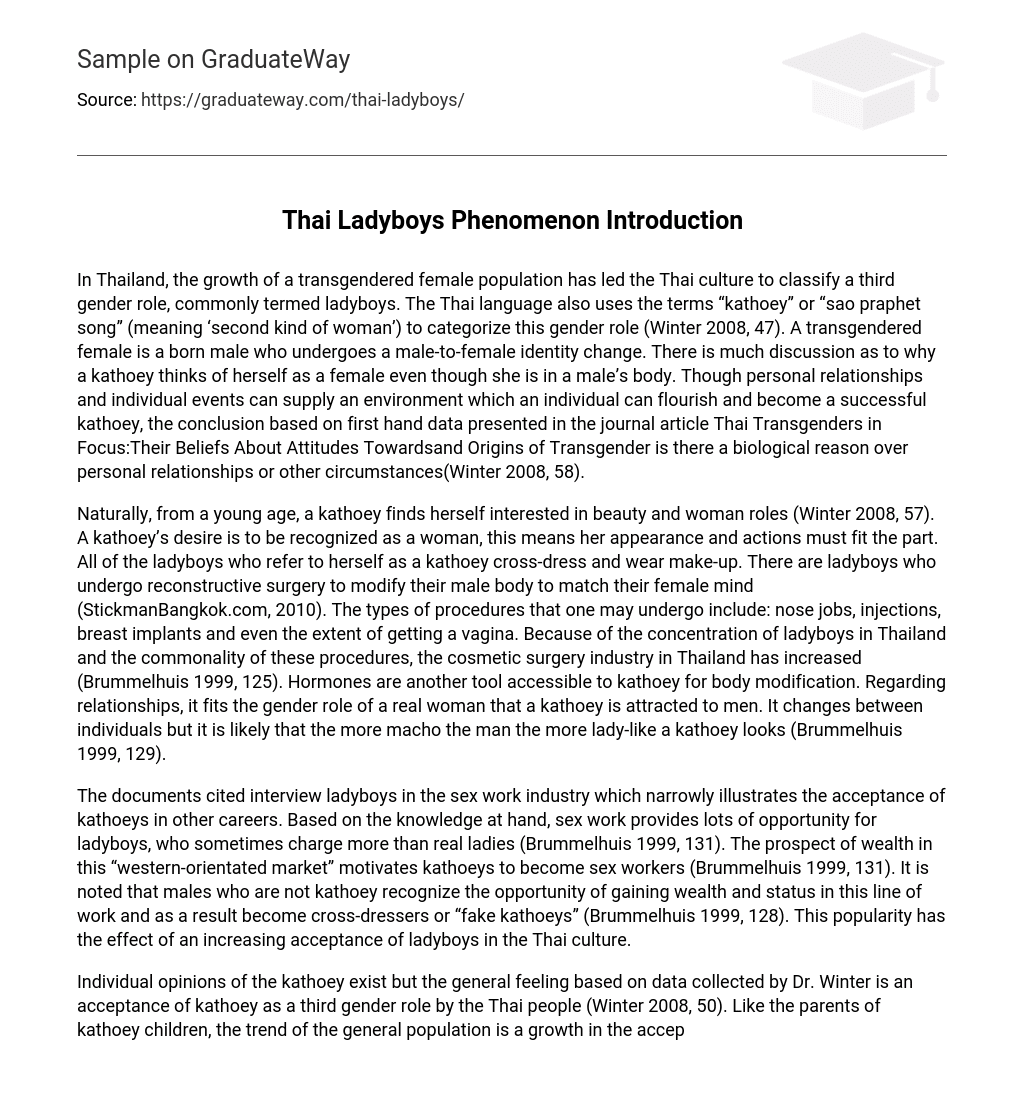In Thailand, there has been an increase in the number of transgendered females, leading to the recognition of a third gender role known as ladyboys. These individuals are also referred to as “kathoey” or “sao praphet song” in the Thai language, which translates to ‘second kind of woman’ (Winter 2008, 47). A transgendered female is someone who was born male but undergoes a gender identity change to become female. The reasons why a kathoey identifies as female despite having a male body are widely discussed. While personal relationships and individual experiences can contribute to the development of a successful kathoey, this journal article suggests that biological factors, as opposed to personal relationships or other circumstances, play a significant role based on first-hand data (Winter 2008, 58).
From a young age, kathoeys show an interest in beauty and female roles (Winter 2008, 57). Their goal is to be acknowledged as women, so their appearance and behavior must match. All kathoeys cross-dress and wear make-up. Some even opt for surgery to alter their male bodies and align them with their female identities (StickmanBangkok.com, 2010). These surgical procedures may include nose jobs, injections, breast implants, and even vaginoplasty. Due to the prevalence of kathoeys in Thailand and the popularity of these procedures, the cosmetic surgery industry in Thailand has experienced growth (Brummelhuis 1999, 125). Hormone therapy is also commonly used by kathoeys for body modification. In terms of relationships, it is typical for kathoeys to be attracted to men as it aligns with traditional gender roles. The more masculine the man, the more feminine the kathoey tends to present themselves (Brummelhuis 1999, 129).
The documents discuss interviews with ladyboys in the sex work industry as a narrow demonstration of how kathoeys are accepted in other professions. According to the available information, sex work offers numerous opportunities for ladyboys, who sometimes charge higher fees compared to cisgender women (Brummelhuis 1999, 131). The desire for wealth in this market, which is influenced by Western culture, motivates kathoeys to enter the sex work industry (Brummelhuis 1999, 131). It is worth mentioning that non-kathoey males also recognize the potential for wealth and status in this field and, as a result, may become cross-dressers or “fake kathoeys” (Brummelhuis 1999, 128). This growing popularity leads to a greater acceptance of ladyboys within Thai society.
According to Dr. Winter, while individual opinions about kathoey may vary, overall, the Thai people accept them as a third gender role. The acceptance of kathoey is increasing over time, similar to how parents of kathoey children are becoming more accepting. As kathoeys become more visible within society, they seem less strange. In fact, their attractiveness has even led to beauty shows that feature exclusively transgender individuals. These events aim to celebrate and appreciate the beauty of kathoeys, attracting both tourists and locals (Brummelhuis 1999, 131; Winter 2008, 50).
In Thai culture, the male-to-female transgender known as a Thai ladyboy has embraced a unique third gender role. The kathoey, as they are called, strive to embody femininity and fulfill their inner desires, fostering a strong sense of unity among their gender. Although the mentioned documents do not shed light on kathoey’s careers beyond sex work, this profession holds significant importance in their gender identity. The opportunities and success found in this field create a supportive environment for kathoey to flourish. Their mesmerizing performances captivate audiences, showcasing the beauty that some possess. Thai society’s growing acceptance and tolerance towards kathoey continue to progress steadily.
The bibliography includes the article “Transformations of the Transgender: The Case of the Thai Kathoey” by Han Ten Brummelhuis, published in the Journal of Gay and Lesbian Social Services in 1999. The article can be found on pages 121-139 and has a DOI of 10.1300/J041v09n02_06.
Sam Winter’s article “Thai Transgender in Focus: Their Beliefs About Attitudes Towards and Origins of Transgender” was published in the International Journal of Transgenderism in 2008 (pp. 47-62). The DOI for the article is 10.1300/J485v09n02_06.
The source of the text is a webpage titled “An Afternoon With Some Thai Ladyboys,” which was last modified on June 13, 2010. The webpage can be found at http://www.stickmanweekly.com/StickmanBangkokWeeklyColumn2010/Bangkok-Ladyboys.htm.





